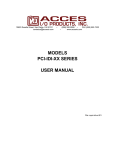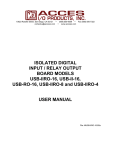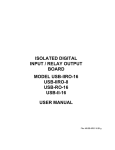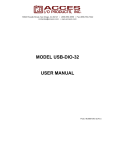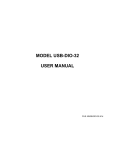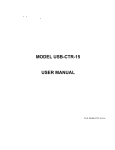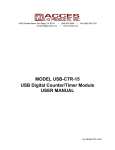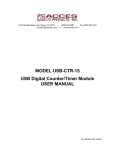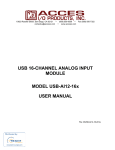Download USB-IDIO-16 - ACCES I/O Products, Inc.
Transcript
10623 Roselle Street, San Diego, CA 92121 (858) 550-9559 Fax (858) 550-7322 [email protected] www.accesio.com MODELS USB-IDIO-16 USB-IDO-16 USB-IDIO-8 ISOLATED DIGITAL INPUT / FET OUTPUT BOARDS USER MANUAL File: MUSB-IDIO-16.A1g Notice The information in this document is provided for reference only. ACCES does not assume any liability arising out of the application or use of the information or products described herein. This document may contain or reference information and products protected by copyrights or patents and does not convey any license under the patent rights of ACCES, nor the rights of others. IBM PC, PC/XT, and PC/AT are registered trademarks of the International Business Machines Corporation. Printed in USA. Copyright 2008 by ACCES I/O Products, Inc. 10623 Roselle Street, San Diego, CA 92121. All rights reserved. WARNING!! ALWAYS CONNECT AND DISCONNECT YOUR FIELD CABLING WITH THE COMPUTER POWER OFF. ALWAYS TURN COMPUTER POWER OFF BEFORE INSTALLING A BOARD. CONNECTING AND DISCONNECTING CABLES, OR INSTALLING BOARDS INTO A SYSTEM WITH THE COMPUTER OR FIELD POWER ON MAY CAUSE DAMAGE TO THE I/O BOARD AND WILL VOID ALL WARRANTIES, IMPLIED OR EXPRESSED. 2 Manual USB-IDIO-16 Warranty Prior to shipment, ACCES equipment is thoroughly inspected and tested to applicable specifications. However, should equipment failure occur, ACCES assures its customers that prompt service and support will be available. All equipment originally manufactured by ACCES which is found to be defective will be repaired or replaced subject to the following considerations. Terms and Conditions If a unit is suspected of failure, contact ACCES' Customer Service department. Be prepared to give the unit model number, serial number, and a description of the failure symptom(s). We may suggest some simple tests to confirm the failure. We will assign a Return Material Authorization (RMA) number which must appear on the outer label of the return package. All units/components should be properly packed for handling and returned with freight prepaid to the ACCES designated Service Center, and will be returned to the customer's/user's site freight prepaid and invoiced. Coverage First Three Years: Returned unit/part will be repaired and/or replaced at ACCES option with no charge for labor or parts not excluded by warranty. Warranty commences with equipment shipment. Following Years: Throughout your equipment's lifetime, ACCES stands ready to provide on-site or in-plant service at reasonable rates similar to those of other manufacturers in the industry. Equipment Not Manufactured by ACCES Equipment provided but not manufactured by ACCES is warranted and will be repaired according to the terms and conditions of the respective equipment manufacturer's warranty. General Under this Warranty, liability of ACCES is limited to replacing, repairing or issuing credit (at ACCES discretion) for any products which are proved to be defective during the warranty period. In no case is ACCES liable for consequential or special damage arriving from use or misuse of our product. The customer is responsible for all charges caused by modifications or additions to ACCES equipment not approved in writing by ACCES or, if in ACCES opinion the equipment has been subjected to abnormal use. "Abnormal use" for purposes of this warranty is defined as any use to which the equipment is exposed other than that use specified or intended as evidenced by purchase or sales representation. Other than the above, no other warranty, expressed or implied, shall apply to any and all such equipment furnished or sold by ACCES. 3 Manual USB-IDIO-16 TABLE OF CONTENTS Chapter 1: Introduction ............................................................................................................................. 5 Features ........................................................................................................................................... 5 Applications ...................................................................................................................................... 5 Inputs................................................................................................................................................ 5 Outputs ............................................................................................................................................. 5 Screw Terminal Accessory Board .................................................................................................... 6 USB Connector ................................................................................................................................ 6 LED .................................................................................................................................................. 6 Figure 1-1: Block Diagram ............................................................................................................... 6 Figure 1-2: Example of One Input Circuit ......................................................................................... 7 Figure 1-3: Example of One Output Circuit ...................................................................................... 7 Ordering Guide ................................................................................................................................. 7 Model Options .................................................................................................................................. 7 Accessories ...................................................................................................................................... 7 Included with your board .................................................................................................................. 7 Chapter 2: Installation ................................................................................................................................ 8 Software CD Installation ................................................................................................................... 8 WIN98/Me/2000/XP/2003 ................................................................................................... 8 Hardware Installation........................................................................................................................ 8 Chapter 3: Option Selection ....................................................................................................................... 9 External Power ................................................................................................................................. 9 Filter Response Jumpers ................................................................................................................. 9 Figure 3-1: Option Selection Map................................................................................................... 10 Chapter 4: USB Address Information ...................................................................................................... 11 Chapter 5: Programming .......................................................................................................................... 12 Chapter 6: Connector Pin Assignments ................................................................................................. 13 Figure 6-1: FET Output Pin Assignments (P3)............................................................................... 13 Figure 6-2: Isolated Input Pin Assignments (P2) ............................................................................ 14 Figure 6-3: USB-STB-84 Screw Terminal Board ........................................................................... 15 Chapter 7: Specification ........................................................................................................................... 16 Isolated Inputs ................................................................................................................................ 16 Isolated FET Outputs ..................................................................................................................... 16 Power Required.............................................................................................................................. 16 Environmental ................................................................................................................................ 17 Customer Comments ................................................................................................................................ 18 4 Manual USB-IDIO-16 Chapter 1: Introduction This 32 channel optically isolated digital I/O board is an ideal solution for adding portable, easy-to-install industrial grade I/O to any computer with a supported USB port. As a USB 2.0 high speed device it offers the fastest speed currently available with the USB bus, while being fully compatible with both USB 1.1 and USB 2.0 ports. The card is plug-and-play allowing for quick connect/disconnect whenever you need additional I/O on your computer. Features High Speed USB 2.0 device, USB 1.1 compatible 16 optically-isolated inputs 16 fully protected and isolated FET 2A outputs Custom high-speed function driver Internal, removable screw terminal board for easy wiring Small (4" x 4" x 1.4") rugged industrial enclosure PC/104 module size and mounting compatibility Applications These boards are especially useful in applications where high common-mode external voltages are present. Isolation is required to guard electronics from transient voltage spikes and offers greater common-mode noise rejection in electronically noisy surroundings containing industrial machinery and inductive loads. These applications include factory automation, energy management, industrial ON/OFF control, security systems, manufacturing test, and process monitoring. In addition to protecting industrial applications from accidental contact with high external voltages, the isolation provided eliminates troublesome ground loops. Inputs The board provides sixteen optically-isolated inputs. These inputs can accept either AC or DC signals and are not polarity sensitive. Input signals are rectified by photocoupler diodes while unused power gets dissipated through a 1.8k-ohm resistor in series. The inputs may be driven by either DC sources of 3 to 31 volts or AC (RMS) sources at frequencies of 40 Hz to 10 kHz. Standard 12/24 AC control transformer outputs can be accepted as well. External resistors connected in series may be used to extend the input voltage range, however this will raise the input threshold range. Consult with factory for available modified input ranges. Each input circuit contains a switchable filter that has a 4.7 millisecond time constant. (Without filtering, the response is less than 40 microseconds.) The filter must be selected for AC inputs in order to eliminate the on/off response to AC. The filter is also valuable for use with slow DC input signals in a noisy environment. The filter may be switched out for DC inputs in order to obtain faster response. Filters are individually selected by jumpers. The filters are switched into the circuit when the jumpers are installed in position FLT0 to FLT15. Outputs The solid state outputs are comprised of sixteen fully protected and isolated FET outputs. The FET’s have built in current limiting and are protected against short-circuit, over- temperature, ESD and inductive load transients. The current limitation is activated until the thermal protection acts. The FET’s are all off at power-on. When powering the unit over the USB cable, with application power connected to the FET’s there is no “sneak-path” to keep the USB module powered on when the USB cable is disconnected. If the USB cable becomes disconnected during control operations the FETs will turn off immediately. When the unit is externally powered (VEXT) in this situation and the USB cable is disconnected, the FETs will remain in their last commanded state. 5 Manual USB-IDIO-16 Screw Terminal Accessory Board A Screw Terminal Accessory board is included with the unit, except for the Economy (E) and OEM versions. The board provides access to all I/O signals via removable screw terminals. Each removable screw terminal carries 8 I/O signals, signal names are clearly marked on the accessory board’s silk screen. The screw terminal board plugs directly onto the I/O board while fitting inside the rugged industrial enclosure. NOTE: Screw termination board is also designed for the USB-isolated input/relay output board. For USB-isolated input/FET output board, please use “FET OUTPUTS” silk screen for correct pin designations. USB Connector The USB connector is a Type B connector and mates with the cable provided. The USB port provides communication signals along with +5 VDC power. The board can be powered from the USB port or, an external power supply can optionally be used if desired. Simply specify the “-P” option when ordering, which includes the on-board DC power jack and circuitry and an external power supply adaptor. LED The LED on the front of the enclosure is used to indicate power and data transmissions. When the LED is in an illuminated steady green state, this signifies that the board is successfully connected to the computer and has been detected and configured by the operating system. When the LED flashes continuously, this signifies that there is data being transmitted over the USB bus. Figure 1-1: Block Diagram 6 Manual USB-IDIO-16 Figure 1-2: Example of One Input Circuit Figure 1-3: Example of One Output Circuit Ordering Guide USB-IDIO-16 USB-IDO-16 USB-IDIO–8 Enclosure, module and screw terminal board 16 isolated FET solid state outputs only version 8 isolated digital inputs and 8 isolated FET solid state outputs version (uses ports 0-7 for inputs and outputs). Model Options -OEM -E -DIN -P Board only version (no enclosure and screw terminal board) Economy model (no screw terminal board) DIN rail mounting provision External power and AC/DC adapter Accessories USB-STB-84 Internal plug in screw termination board Included with your board The following components are included with your shipment. Please take time now to ensure that no items are damaged or missing. 1. 2. 3. 4. USB-Isolated Input/FET Output Board (unit installed in labeled enclosure) 6’ USB cable Software Master CD (PDF user manual installed with product package) Printed USB I/O Quick-Start Guide 7 Manual USB-IDIO-16 Chapter 2: Installation Software CD Installation These paragraphs are intended to detail the software installation steps. The software provided with this board is contained on one CD and must be installed onto your hard disk prior to use. To do this, perform the following steps as appropriate for your operating system. Substitute the appropriate drive letter for your drive where you see d: in the examples below. WIN98/Me/2000/XP/2003 a. b. c. Place the CD into your CD-ROM drive. The CD should automatically run the install program. If the install program does not click START | RUN and type , click OK or press . Follow the on-screen prompts to install the software for this board. Hardware Installation The board can be installed in any USB 2.0 or USB 1.1 port. Please refer to the USB I/O Quick Start Guide which can be found on the CD, for specific, quick steps to complete the hardware and software installation. 8 Manual USB-IDIO-16 Chapter 3: Option Selection Refer to the setup programs on the CD provided with the board. Also, refer to the Block Diagram and the Option Selection Map when reading this section of the manual. External Power This is an option for applications that use more current than what your computer can provide on the USB port (typically 500 mA). The DC jack has a 2.00mm post on board and is designed to be used with the 9 VDC AC/DC external power supply that ships with this option. The voltage regulator on board regulates the 9 VDC and provides 5 VDC to the onboard circuitry. When using external power, switch the jumper located near the USB connector to VEXT, otherwise when the jumper is in the VUSB position current is drawn from the USB port. Filter Response Jumpers Jumpers are used to select input filtering on a channel-by-channel basis. When jumper FLT0 is installed, additional filtering is introduced for input bit 0, FLT1 for bit 1, etc. JUMPER SELECTION FLT-0 FLT-1 FLT-2 FLT-3 FLT-4 FLT-5 FLT-6 FLT-7 Bit Filtered IN00 IN01 IN02 IN03 IN04 IN05 IN06 IN07 JUMPER SELECTION FLT-8 FLT-9 FLT-10 FLT-11 FLT-12 FLT-13 FLT-14 FLT-15 Bit Filtered IN08 IN09 IN10 IN11 IN12 IN13 IN14 IN15 This additional filtering provides a slower response for DC signals as described previously and must be used when AC inputs are applied. 9 Manual USB-IDIO-16 Figure 3-1: Option Selection Map 10 Manual USB-IDIO-16 Chapter 4: USB Address Information Use the provided driver to access the USB board. This driver will allow you to determine how many supported USB devices are currently installed, and each device’s type. This information is returned as a Vendor ID (VID), Product ID (PID) and Device Index. The board’s VID is “0x1605", and its PID is “0x8018". The Device Index is determined by how many of the device you have in your system, and provides a unique identifier allowing you to access a specific board at will. 11 Manual USB-IDIO-16 Chapter 5: Programming The driver software provided with the board uses a 32-bit .dll front end compatible with any Windows programming language. Samples provided in Borland C++Builder, Borland Delphi, Microsoft Visual Basic, and Microsoft Visual C++ demonstrate the use of the driver. The following functions are provided by the driver in Windows. These functions will allow you to read or write individual bits, bytes, or the entire board worth of data. In addition, counter-timer functionality and board-level functions complete the driver package. For detailed information on each function refer to the .html Driver Manual located in the Win32 directory for this board. unsigned long GetDevices(void ) unsigned long QueryDeviceInfo(DeviceIndex, pPID, pName, pDIOBytes, pCounters) unsigned long DIO_Configure(DeviceIndex, bTristate, pOutMask, pData) unsigned long DIO_Write1(DeviceIndex, BitIndex, bData) unsigned long DIO_Write8(DeviceIndex, ByteIndex, Data) unsigned long DIO_WriteAll(DeviceIndex,pData) unsigned long DIO_Read8(DeviceIndex, ByteIndex,pBuffer) unsigned long DIO_ReadAll(DeviceIndex,Buffer) 12 Manual USB-IDIO-16 Chapter 6: Connector Pin Assignments FET outputs are connected to the board via a 50-pin HEADER type connector named P3. The mating connector is an IDC type with 0.1 inch centers or equivalent. Normally, a screw terminal accessory (USBSTB-84) is included and installed directly on to the board headers. Pin assignments follow. PIN 1 2 3 4 5 6 7 8 9 10 11 12 13 14 15 16 17 18 19 20 21 22 23 24 25 26 27 28 29 30 31 32 33 34 35 36 37 38 39 40 41 42 43 44 45 46 47 48 49 50 NAME OUT15+ OUT15VBB OUT15OUT14+ OUT14VBB OUT14OUT13+ OUT13VBB OUT13OUT12+ OUT12VBB OUT12OUT11+ OUT11VBB OUT11OUT10+ OUT10VBB OUT10OUT09+ OUT09VBB OUT09OUT08+ OUT08VBB OUT08- FUNCTION Bit 15 Switched (Supply Voltage) Output Bit 15 FET Supply Voltage Bit 15 Power Supply Return (or Ground) Bit 14 Switched (Supply Voltage) Output Bit FET Supply Voltage Bit 14 Power Supply Return (or Ground) Bit 13 Switched (Supply Voltage) Output Bit 13 FET Supply Voltage Bit 13 Power Supply Return (or Ground) Bit 12 Switched (Supply Voltage) Output Bit 12 FET Supply Voltage Bit 12 Power Supply Return (or Ground) Bit 11 Switched (Supply Voltage) Output Bit 11 FET Supply Voltage Bit 11 Power Supply Return (or Ground) Bit 10 Switched (Supply Voltage) Output Bit 10 FET Supply Voltage Bit 10 Power Supply Return (or Ground) Bit 09 Switched (Supply Voltage) Output Bit 09 FET Supply Voltage Bit 09 Power Supply Return (or Ground) Bit 08 Switched (Supply Voltage) Output Bit 08 FET Supply Voltage Bit 08 Power Supply Return (or Ground) OUT07OUT07VBB OUT07+ OUT06OUT06VBB OUT06+ OUT05OUT05VBB OUT05+ OUT04OUT04VBB OUT04+ OUT03OUT03VBB OUT03+ OUT02OUT02VBB OUT02+ OUT01OUT01VBB OUT01+ OUT00OUT00VBB OUT00+ Bit 07 Power Supply Return (or Ground) Bit 07 FET Supply Voltage Bit 07 Switched (Supply Voltage) Output Bit 06 Power Supply Return (or Ground) Bit 06 FET Supply Voltage Bit 06 Switched (Supply Voltage) Output Bit 05 Power Supply Return (or Ground) Bit 05 FET Supply Voltage Bit 05 Switched (Supply Voltage) Output Bit 04 Power Supply Return (or Ground) Bit 04 FET Supply Voltage Bit 04 Switched (Supply Voltage) Output Bit 03 Power Supply Return (or Ground) Bit 03 FET Supply Voltage Bit 03 Switched (Supply Voltage) Output Bit 02 Power Supply Return (or Ground) Bit 02 FET Supply Voltage Bit 02 Switched (Supply Voltage) Output Bit 01 Power Supply Return (or Ground) Bit 01 FET Supply Voltage Bit 01 Switched (Supply Voltage) Output Bit 00 Power Supply Return (or Ground) Bit 00 FET Supply Voltage Bit 00 Switched (Supply Voltage) Output Figure 6-1: FET Output Pin Assignments (P3) 13 Manual USB-IDIO-16 Isolated Inputs are connected to the board via a 34-pin HEADER type connector named P2. The mating connector is an IDC type with 0.1 inch centers or equivalent. PIN 1 2 3 4 5 6 7 8 9 10 11 12 13 14 15 16 17 18 19 20 21 22 23 24 25 26 27 28 29 30 31 32 33 34 NAME IN00 A IN00 B IN01 A IN01 B IN02 A IN02 B IN03 A IN03 B IN04 A IN04 B IN05 A IN05 B IN06 A IN06 B IN07 A IN07 B FUNCTION Isolated Input 00 A Isolated Input 00 B Isolated Input 01 A Isolated Input 01 B Isolated Input 02 A Isolated Input 02 B Isolated Input 03 A Isolated Input 03 B Isolated Input 04 A Isolated Input 04 B Isolated Input 05 A Isolated Input 05 B Isolated Input 06 A Isolated Input 06 B Isolated Input 07 A Isolated Input 07 B IN08 A IN08 B IN09 A IN09 B IN10 A IN10 B IN11 A IN11 B IN12 A IN12 B IN13 A IN13 B IN14 A IN14 B IN15 A IN15 B Isolated Input 08 A Isolated Input 08 B Isolated Input 09 A Isolated Input 09 B Isolated Input 10 A Isolated Input 10 B Isolated Input 11 A Isolated Input 11 B Isolated Input 12 A Isolated Input 12 B Isolated Input 13 A Isolated Input 13 B Isolated Input 14 A Isolated Input 14 B Isolated Input 15 A Isolated Input 15 B Figure 6-2: Isolated Input Pin Assignments (P2) 14 Manual USB-IDIO-16 Figure 6-3: USB-STB-84 Screw Terminal Board 15 Manual USB-IDIO-16 Chapter 7: Specification Isolated Inputs Number of inputs: Sixteen Type: Non-polarized, optically isolated from each other and from the computer Voltage Range: 3 to 31 DC or AC RMS (40 Hz to 10 kHz) (CMOS compatible) Isolation: 500V*(see note) channel-to-ground or channel-to channel Input Resistance: 1.8K ohms in series with opto coupler Filter Response: Rise Time = 4.7 mS / Fall Time = 4.7 mS Non-Filter Response: Rise Time = 10 uS / Fall Time = 30 uS Isolated FET Outputs Number of outputs: Sixteen Solid State FET’s (off @ power up) Output Type: High Side Power MOSFET Switch. Protected against short circuit, overtemperature, ESD, can drive inductive loads. Voltage Range: 5-34VDC recommended (customer supplied) for continuous use, 40VDC absolute maximum Current Rating: 2A maximum Turn-on time: 90 uS (typical) Turn-off time: 110 uS (typical) Power Required 5V @ 35mA typical (all FETs off, add 5mA per FET) 5V @ 115mA typical (all FETs on) 5VDC provided via USB cable up to 500mA** **optional external power supply can be ordered if desired if current use of the board is expected to be greater than what can be supplied by the USB cable. Environmental Operating Temp: o 0 - 70 C (Non-icing) *Notes on Isolation: Opto-Isolators and connectors are rated for at least 500V, but isolation voltage breakdowns will vary and is affected by factors like cabling, spacing of pins, spacing between traces on the PCB, humidity, dust and other environmental factors. This is a safety issue so a careful approach is required. For CE certification on the front end of the circuitry, isolation was specified at 40V AC and 60V DC. The design intention was to eliminate the influence of common mode. Use proper wiring techniques to minimize voltage between channels and to ground. For example, when working with AC voltages do not connect the hot side of the line to an input. Tolerance of higher isolation voltage can be obtained on request by applying a conformal coating to the board. 16 Manual USB-IDIO-16 Customer Comments If you experience any problems with this manual or just want to give us some feedback, please email us at: [email protected]. Please detail any errors you find and include your mailing address so that we can send you any manual updates. 10623 Roselle Street, San Diego CA 92121 Tel. (858)550-9559 FAX (858)550-7322 www.accesio.com 17 Manual USB-IDIO-16

















